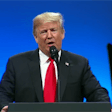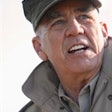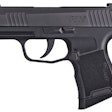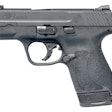On July 27, Phoenix police officer George Cortez, Jr. was shot in the eye and killed after being distracted while handcuffing a suspect.
On August 13, Broward County Sheriff's detective Maury Hernandez was also shot in the head. His shooter explained the assault by saying that he wanted to avoid going to jail so that he could see the birth of his child—the next in a doubtless line of rewarding progeny.
Then while Hernandez was fighting for his life on a ventilator, a fellow Broward County deputy, Sgt. Chris Reyka, was shot in the head and killed while running vehicle tags in a parking lot. His killer remains at large as of this writing.
Take note, the bad guys have realized that shooting us center mass is likely to have little effect because of our body armor. Accordingly, they are head hunting.
In the Hernandez case, the suspect, David Maldonado, was particularly known for his head shot proficiency, establishing tight patterns on paper targets at a local firing range.
As San Francisco Prosecutor Harold Jewett noted during the trial of yet another cop killer earlier this month, "When you shoot at someone's head, you're intending to kill them."
What can you and your agencies do to deal with this growing threat?
The first thing is to recognize that while cops are not getting killed with the frequency that they were in the early 1970s, it's not been for lack of effort. Suspects have continued to take the fight to us, attacking officers in every manner ranging from spontaneous acts of violence, to deliberate and calculated ambushes.
But the succeeding three decades have seen three big changes that have made it more likely for us to survive an attack: The first is the practice of employing improved tactics (some of which have been taught to a broader audience via television shows such as "COPS"); the second is the emergence of the bulletproof vest, and the third is improved emergency medical treatment.
Body armor and advanced medical treatment has saved the lives of thousands of assaulted officers.
The body armor saves have also led to publicity, which has two results: It has convinced cops to wear their vests and it has informed the violent criminal community that cops are wearing vests. Criminals are adaptive, so their aim has veered north from center mass.
And just as they have adapted, perhaps we should further adapt, as well.
What are our options?
Well, it's worth noting that each of the officers shot were working alone at the time of their shooting. While two-man cars have incurred similar losses, it isn't exactly counter-intuitive to consider the possibility that two-man cars are inherently safer. At least they offer a better chance for officers to get the upper hand on suspects. It'd be nice if more agencies deployed two-man patrol cars.
But even if more agencies were able to pony up the money for two-man patrols, the fact remains that one-man cars are and will continue to be a part of policing. And within them are cops who know full-well the risk of such solitary endeavor, but nonetheless engage in proactive police work.
Sgt. Reyka was such a man, having been recently honored as Officer of the Month for making a GTA arrest and for identifying and arresting burglary suspects in separate incidents.
Simply put, there are some cops who go above and beyond, and routinely place themselves in harm's way, however officer safety conscious they might otherwise be.
It's not as though law enforcement is particularly apathetic for its officers' safety. We send them to training, have them fire numerous rounds down range, and familiarize them with a variety of shooting drills.
But while it's great for officers to practice double-tapping at the range, it may prove for naught if the suspect gets a lucky first shot at the officer's head.
Unfortunately, there are not a lot of solutions to this problem. Because officers must react to the violent action or perceived violent intent of a subject before firing, the bad guys have ample opportunity to make the first move.
One possible solution might be to equip patrol officers with ballistic helmets. But I'm not sure that this would have much benefit.
Most ballistic helmets I've seen offer low caliber protection against a rear assault or side assault, but the officer's face is open and vulnerable.
Law enforcement officials might consider consulting with private industry as well as the scientific community (e.g., MIT, Cal Tech, and other engineering institutions) and ask them to create protection for the heads of officers. Given evolving technology and chemical compositions, I'm sure that some user-friendly ballistic head gear is not only viable, but at least for some cops—given the areas they're working in—necessary.
True, even if some company developed excellent head protection for patrol officers, some officers would abstain from wearing it, just as some cops refuse to this day to wear ballistic vests. But shouldn't they at least be able to make that decision on their own, as opposed to having their heads relegated to target duty in the meantime?
Before our streets increasingly come to resemble outtakes from "The Departed," it's time for administrators to wrap their minds around something that can wrap around the minds of their officers.
Of course, the resulting design of such helmets may end up looking intimidating. But personally, I think an intimidating helmet might be just what we need. Maybe it'll cause some trigger-happy bastard to think twice before taking a shot at a cop.
Unfortunately, the same bureaucrats that would install rainbow stickers in patrol car windows and offer up pastel colors on their frames would probably shoot down the idea because it makes the cops look too much like the military. Of course, these folks would not even consider the threat that cops face from head shots before they reject the helmets. You see, they've never worked patrol.











